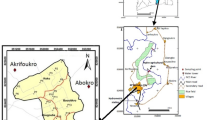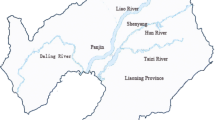Abstract
Prediction and sensitivity models, to elucidate the response of phytoplankton biomass to environmental factors in Quanzhou Bay, Fujian, China, were developed using a back propagation (BP) network. The environmental indicators of coastal phytoplankton biomass were determined and monitoring data for the bay from 2008 was used to train, test and build a three-layer BP artificial neural network with multi-input and single-output. Ten water quality parameters were used to forecast phytoplankton biomass (measured as chlorophyll-a concentration). Correlation coefficient between biomass values predicted by the model and those observed was 0.964, whilst the average relative error of the network was −3.46% and average absolute error was 10.53%. The model thus has high level of accuracy and is suitable for analysis of the influence of aquatic environmental factors on phytoplankton biomass. A global sensitivity analysis was performed to determine the influence of different environmental indicators on phytoplankton biomass. Indicators were classified according to the sensitivity of response and its risk degree. The results indicate that the parameters most relevant to phytoplankton biomass are estuary-related and include pH, sea surface temperature, sea surface salinity, chemical oxygen demand and ammonium.
Similar content being viewed by others
References
Beaufort L, Probert I, Garidel-Thoron de T et al. 2011. Sensitivity of coccolithophores to carbonate chemistry and ocean acidification. Nature, 476: 80–83.
Berg G M, Glibert P M, Lomas M W et al. 1997. Organic nitrogen uptake and growth by the chrysophyte Aureococcus anophagefferens during a brown tide event. Marine Biology, 129: 377–387.
Boyd P W, Strzepek R, Fu F X et al. 2010. Environmental control of open-ocean phytoplankton groups: Now and in the future. Limnology & Oceanography, 55(3): 1 353–1 376.
Bricker S B, Ferreira J G, Simas T. 2003. An integrated methodology for assessment of estuarine trophic status. Ecol. Modelling, 169: 39–60.
Cai Y, Xing Y, Hu D. 2008. On sensitivity analysis. Journal of Beijing Normal University (Natural Science), 44: 9–15. (in Chinese with English abstract)
Campolongo F, Saltelli A, Sorensen T et al. 2000. Hitchhiker’s guide to sensitivity. In: Saltelli A, Chan K, Scott E M eds. Sensitivity Analysis. John Wiley and Sons, Chichester, England. p.15–45.
Chen B, Huang H, Yu W, Zheng S, Wang J, Jiang J. 2009. Marine biodiversity conservation based on integrated coastal zone management (ICZM): a case study in Quanzhou Bay, Fujian, China. Ocean & Coastal Management, 52: 612–619.
Cornford D. 2004. A Bayesian state space modelling approach to probabilistic quantitative precipitation forecasting. Journal of Hydrology, 288(1–2): 92–104.
Cossarini G, Solidoro C. 2008. Global sensitivity analysis of a trophodynamic model of the Gulf of Trieste. Ecol. Modelling, 212: 16–27.
Franks P J S, Chen C. 1996. Plankton production in tidal fronts: a model of Georges Bank in summer. Journal of Marine Research, 54: 631–651.
Fujii M, Yoshie N, Yamanaka Y, Chai F. 2005. Simulated biogeochemical responses to iron enrichments in three high nutrient, low chlorophyll (HNLC) regions. Progress in Oceanography, 64: 307–324.
Gao H W, Sun W X, Zhai X M. 1997. Sensitive analysis of the parameters of a pelagic ecosystem dynamic model. Journal of Ocean University of Qingdao, 29: 398–404. (in Chinese with English abstract)
Gao M, Shi H, Li Z. 2009. Chaos in a seasonally and periodically forced phytoplankton-zooplankton system. Nonlinear Analysis: Real World Applications, 10: 1 643–1 650.
Geider R J, MacIntyre H L, Kana T M. 1997. Dynamic model of phytoplankton growth and acclimation: responses of the balanced growth rate and the chlorophyll a: carbon ratio to light, nutrient-limitation and temperature. Marine Ecology Progress Series, 148: 187–200.
Granéli E, Weberg M, Salomon P S. 2008. Harmful algal blooms of allelopathic microalgal species: the role of eutrophication. Harmful Algae, 8: 94–102.
Halpern B S, Walbridge S, Selkoe K A, Kappel C V, Micheli F, D’Agrosa C et al. 2008. A global map of human impact on marine ecosystems. Science, 319: 948–952.
Hilbert D W, Ostendorf B. 2001. The utility of artificial neural networks for modelling the distribution of vegetation in past, present and future climates. Ecol. Modelling, 146: 311–327.
Hood R R, Lawsb E A, Armstrong R A et al. 2006. Pelagic functional group modeling: progress, challenges and prospects. Deep Sea Res. II, 53: 459–512.
Huang Z G. 2004. Biodiversity on Marine Estuarine Wetland. Ocean Press, Beijing, China. p.1–426. (in Chinese)
Jackson J B C, Kirby M X, Berger W H, Bjorndal K A, Botsford L W, Bourque B J et al. 2001. Historical overfishing and the recent collapse of coastal ecosystems. Science, 293: 629–638.
Li P W, Lai E ST. 2004. Short-range quantitative precipitation forecasting in Hong Kong. Journal of Hydrology, 288(1–2): 189–209.
Lomas M W, Glibert P M. 2000. Comparisons of nitrate uptake, storage, and reduction in marine diatoms and flagellates. J. Phycol., 36: 903–913.
Lopes J F, Cardoso A C, Moita M T, Rocha A C, Ferreira J A. 2009. Modelling the temperature and the phytoplankton distributions at the Aveiro near coastal zone, Portugal. Ecol. Modelling, 220: 940–961.
Lotze H K, Lenihan H S, Bourque B J, Bradbury R. 2006. Depletion, degradation, and recovery potential of estuaries and coastal seas. Science, 312: 1 806–1 809.
Maguer J F, L’Helguen S, Waeles M, Morin P, Riso R, Caradec J. 2009. Size-fractionated phytoplankton biomass and nitrogen uptake in response to high nutrient load in the North Biscay Bayinspring. Continental Shelf Research, 29: 1 103–1 110.
Myers R A, Worm B. 2003. Rapid worldwide depletion of predatory fish communities. Nature, 423: 280–283, http://dx.doi.org/10.1038/nature01610.
Nickerson D M, Madsen B C. 2005. Nonlinear regression and ARIMA models for precipitation chemistry in East Central Florida from 1978 to 1997. Environmental Pollution, 135(3): 371–379.
Nogueira E, Woods J D, Harris C, Field A J, Talbot S. 2006. Phytoplankton co-existence: results from an individualbased simulation model. Ecol. Modelling, 198: 1–22.
Olden J D. 2000. An artificial neural network approach for studying phytoplankton succession. Hydrobiologia, 436: 131–143.
Pasini A, Lorè M, Ameli F. Neural network modelling for the analysis of forcings/temperatures relationships at different scales in the climate system. Ecol. Modelling, 2006, 191: 58–67.
Pei H X, Luo N N, Jiang Y. 2004. Application s of back propagation neural network for predicting the concentration of chlorophyll-a in west lake. Acta Ecologica Sinica, 24(2): 246–251.
Rocap G, Larimer F W, Lamerdin J et al. 2003. Genome divergence in two Prochlorococcus ecotypes reflects oceanic niche differentiation. Nature, 424: 1 042–1 047.
Saltelli A. 2000. What is sensitivity analysis? In: Saltelli A, Chan K, Scott E M eds. Sensitivity Analysis. John Wiley and Sons, Chichester, England. p.3–12.
Scardi M. 2001. Advances in neural network modeling of phytoplankton primary production. Ecol. Modelling, 146(1–3): 33–45.
Shi H H, Fang G H, Sun Y M, Zheng W, Hu L. 2010. Simulation of phytoplankton biomass in Jiaozhou Bay by means of BP network model. Journal of Waterway and Harbor, 31: 545–548. (in Chinese with English abstract)
Shiomoto A, Sasaki K, Shimoda T et al. 1994. Kinetics of nitrate and ammonium uptake by the natural populations of marine phytoplankton in the surface water of the Oyashio region during spring and summer. Journal of Oceanography, 50: 515–529.
Wang H L, Feng J F. 2006. Ecosystem Dynamics and Forecasting of Algal Blooms. Tianjin University Press, Tianjin, China. p.1–279. (in Chinese)
Wesberry T K, Siegel D A. 2006. Spatial and temporal distribution of Trichodesmium blooms in the world’s oceans. Global Biogeochemical Cycles, 20: GB4016, http://dx.doi.org/10.1029/2005GB002673.
Yang J Q, Luo X X, Ding D W, Qin J. 2003. A preliminary study on artificial neural network method for predicting red tide. Advances in Marine Science, 21(3): 318–324. (in Chinese with English abstract)
Author information
Authors and Affiliations
Corresponding author
Additional information
Supported by the Ocean Public Welfare Scientific Research Project, State Oceanic Administration of China (No. 200705029), the National Special Fund for Basic Science and Technology of China (No. 2012FY112500), and the National Non-profit Institute Basic Research Fund (No. FIO2011T06)
Rights and permissions
About this article
Cite this article
Zheng, W., Shi, H., Song, X. et al. Simulation of phytoplankton biomass in Quanzhou Bay using a back propagation network model and sensitivity analysis for environmental variables. Chin. J. Ocean. Limnol. 30, 843–851 (2012). https://doi.org/10.1007/s00343-012-1216-6
Received:
Accepted:
Published:
Issue Date:
DOI: https://doi.org/10.1007/s00343-012-1216-6




